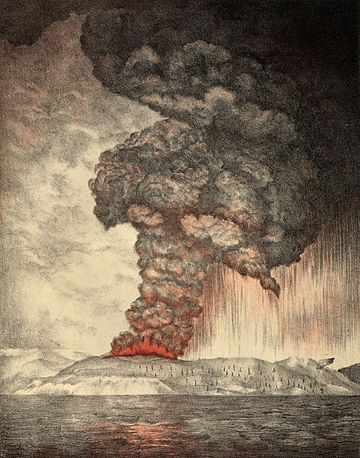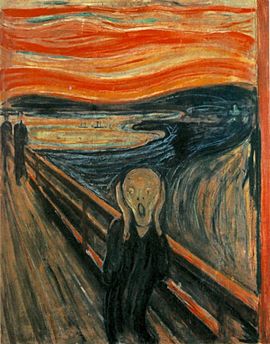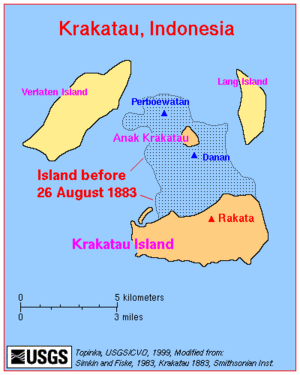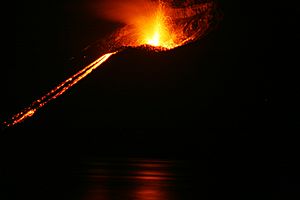Krakatoa facts for kids
Quick facts for kids Krakatoa |
|
|---|---|

An 1888 lithograph of the 1883 eruption of Krakatoa.
|
|
| Highest point | |
| Prominence | 813 m (2,667 ft) |
| Geography | |
| Location | Indonesia |
| Geology | |
| Mountain type | Caldera |
| Last eruption | 2020 |
Krakatoa, also called Krakatau, is a famous caldera (a large volcanic crater) located in the Sunda Strait. This strait is a narrow sea passage between the islands of Java and Sumatra in Indonesia. Krakatoa is part of a group of volcanic islands. These islands include Lang and Verlaten, which are parts of an older volcano. The island of Rakata is also a remnant of a much larger island that was destroyed in the huge 1883 eruption.
Krakatoa is a type of volcano called a stratovolcano. These volcanoes are usually tall and cone-shaped, built up by many layers of hardened lava, ash, and rock.
In 1927, a new island appeared from the caldera formed in 1883. This island was named Anak Krakatau, which means "Child of Krakatoa." Since the late 1900s, Anak Krakatau has been very active. On December 22, 2018, its central cone collapsed. This caused a deadly tsunami (a giant ocean wave) in the Sunda Strait, killing more than 400 people.
Contents
What's in a Name?
The first time people in the Western world mentioned Krakatoa was on a map by Lucas Janszoon Waghenaer. He called the island "Pulo Carcata." "Pulo" is an old form of pulau, which means "island" in Indonesian.
Both "Krakatoa" and "Krakatau" are correct spellings. "Krakatoa" is more common around the world. However, people in Indonesia often prefer "Krakatau." No one is really sure why the "oa" spelling started. It might have been a mistake in a British report about the 1883 eruption. The Dutch, who used to rule Indonesia, spelled it "Krakatowa." This was probably to make sure it was pronounced correctly in Dutch.
There are a few ideas about where the Indonesian name Krakatau came from:
- It might sound like the noise made by white parrots that used to live on the island. This is called Onomatopoeia.
- It could come from the ancient Sanskrit words karka or karkata. These words mean "lobster" or "crab."
- It might also come from the Malayan word kelakatu, which means "white-winged ant."
A funny story says that "Krakatau" came from a misunderstanding. The story goes that a ship captain asked a local person the island's name. The local person replied, "Kaga tau" (pronounced Kah-gah tow), which means "I don't know" in a local Indonesian slang. But this story is probably just a myth. It's similar to other stories about how words like "kangaroo" or "Yucatán Peninsula" got their names.
Where is Krakatoa Located?
Indonesia has over 130 active volcanoes, more than any other country! These volcanoes form a line across Indonesia. This line is created by the movement of huge pieces of the Earth's crust called tectonic plates. The Indo-Australian Plate is slowly sliding under the Eurasian Plate. This process is called subduction.
Most of Indonesia's volcanoes are on its two largest islands, Java and Sumatra. The Sunda Strait, where Krakatoa is, separates these two islands. Krakatoa sits right above this subduction zone. The way the plates meet here might make the Earth's crust in this area weaker. This could explain why there are so many volcanoes.
Krakatoa Before 1883
Before the massive eruption in 1883, Krakatoa was made up of three islands. These were Lang, Verlaten, and Krakatoa itself. Lang and Verlaten were leftover parts from a very old, huge eruption.
On Krakatoa island, there were three volcanoes:
- Rakata, which was about 820 meters (2,690 feet) tall, in the south.
- Danan, about 450 meters (1,476 feet) tall, near the center.
- Perboewatan, about 120 meters (394 feet) tall, in the north.
The Great 1883 Eruption
The 1883 eruption of Krakatoa was one of the most powerful volcanic events in recorded history. It blasted out more than 25 cubic kilometers (6 cubic miles) of rock, ash, and pumice. The sound of the final explosion was the loudest ever recorded by humans! People heard it as far away as Perth in Australia, which is about 3,500 kilometers (2,200 miles) away. It was also heard on the island of Rodrigues near Mauritius, about 4,800 kilometers (3,000 miles) away.
Thousands of people were killed and injured by the eruption. Most of them died from the giant tsunami (ocean wave) that followed the explosion.
The powerful shock wave from the final explosion traveled around the entire world. Special instruments called barographs recorded it for up to five days after the blast. These recordings showed that the shock wave went around the globe seven times!
The eruption destroyed two-thirds of the original Krakatoa island. But since 1927, new eruptions have built a new island called Anak Krakatau, or "Child of Krakatoa."
What Happened After?
Birth of Anak Krakatau
After the 1883 eruption, scientists wondered where new volcanic activity might happen. A scientist named Verbeek predicted that any new eruptions would appear in the area between the old Perboewatan and Danan volcanoes. His prediction came true!
On December 29, 1927, a new lava dome started erupting underwater in that exact spot. A few days later, a new island volcano rose above the water. At first, the eruptions produced pumice and ash. The sea quickly washed away these early islands. But eventually, a fourth island, named Anak Krakatau (meaning "child of Krakatoa"), appeared in August 1930. This time, it produced lava flows faster than the waves could erode them, so the island grew and stayed.
Life Returns to the Islands
The Krakatoa islands became a special place for scientists to study how life returns to an area that has been completely destroyed. This is called island biogeography.
Before the 1883 eruption, not many studies had been done on the plants and animals of Krakatoa. The island probably had a typical tropical forest. After the eruption, the islands were almost completely empty of life. When the first researchers visited in May 1884, they found only one living thing: a spider hiding in a crack on Rakata.
But life quickly came back! By October 1884, grass shoots were already growing. The eastern side of the island is now covered with trees and shrubs. Seeds were likely carried there by ocean currents or by birds. Some might have been brought by people too. However, the plants on Rakata can be easily damaged by new eruptions from Anak Krakatau.
Protecting Krakatoa
Krakatoa was made a nature reserve in 1921. This means it's a special area protected for its natural importance. In 1991, "Ujung Kulon National Park and Krakatau Nature Reserve" became a UNESCO World Heritage Site. This means it's recognized as a very important natural place for the whole world. In 1992, Ujung Kulon National Park was officially created, and it includes Krakatoa.
Krakatoa in Books and Movies


Krakatoa has appeared in many stories, movies, and even music!
- A big part of the 1947 children's book The Twenty-One Balloons by William Pène du Bois takes place on Krakatoa. In the story, families set up a rich and imaginative colony there, based on made-up diamond mines.
- The island has been featured in several films and TV shows. For example, the 1953 film Fair Wind to Java shows a race to find diamonds on Krakatoa as it starts to erupt.
- It was also a main part of the story in the 1969 film, Krakatoa, East of Java. (Fun fact: the title has a geographical mistake, as Krakatoa is actually west of Java!)
- In 1973, the American rock band Styx released a song called "Krakatoa." It tells the story of the eruption and how life returned to the island.
Related pages
Images for kids
See also
 In Spanish: Krakatoa para niños
In Spanish: Krakatoa para niños









